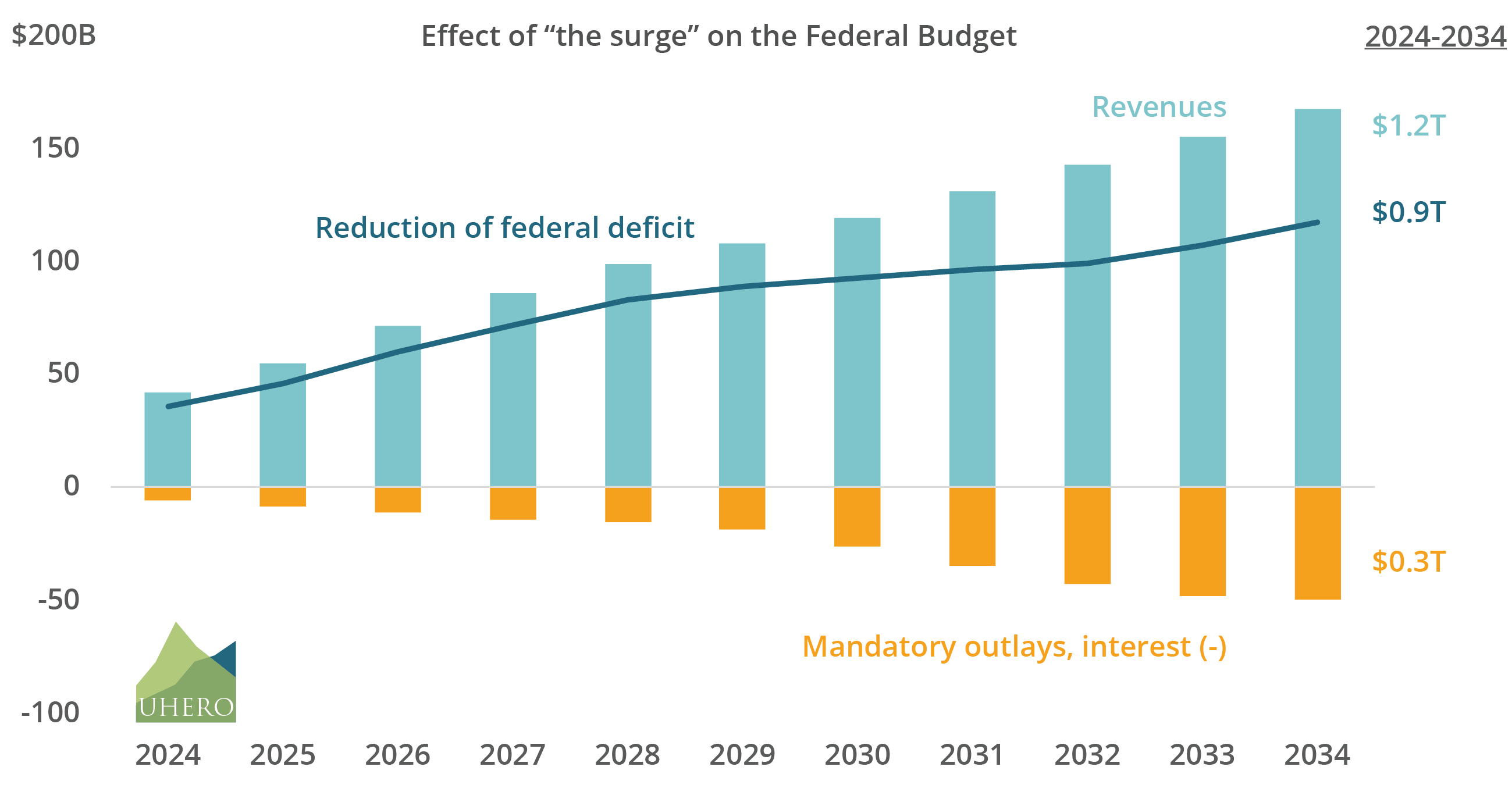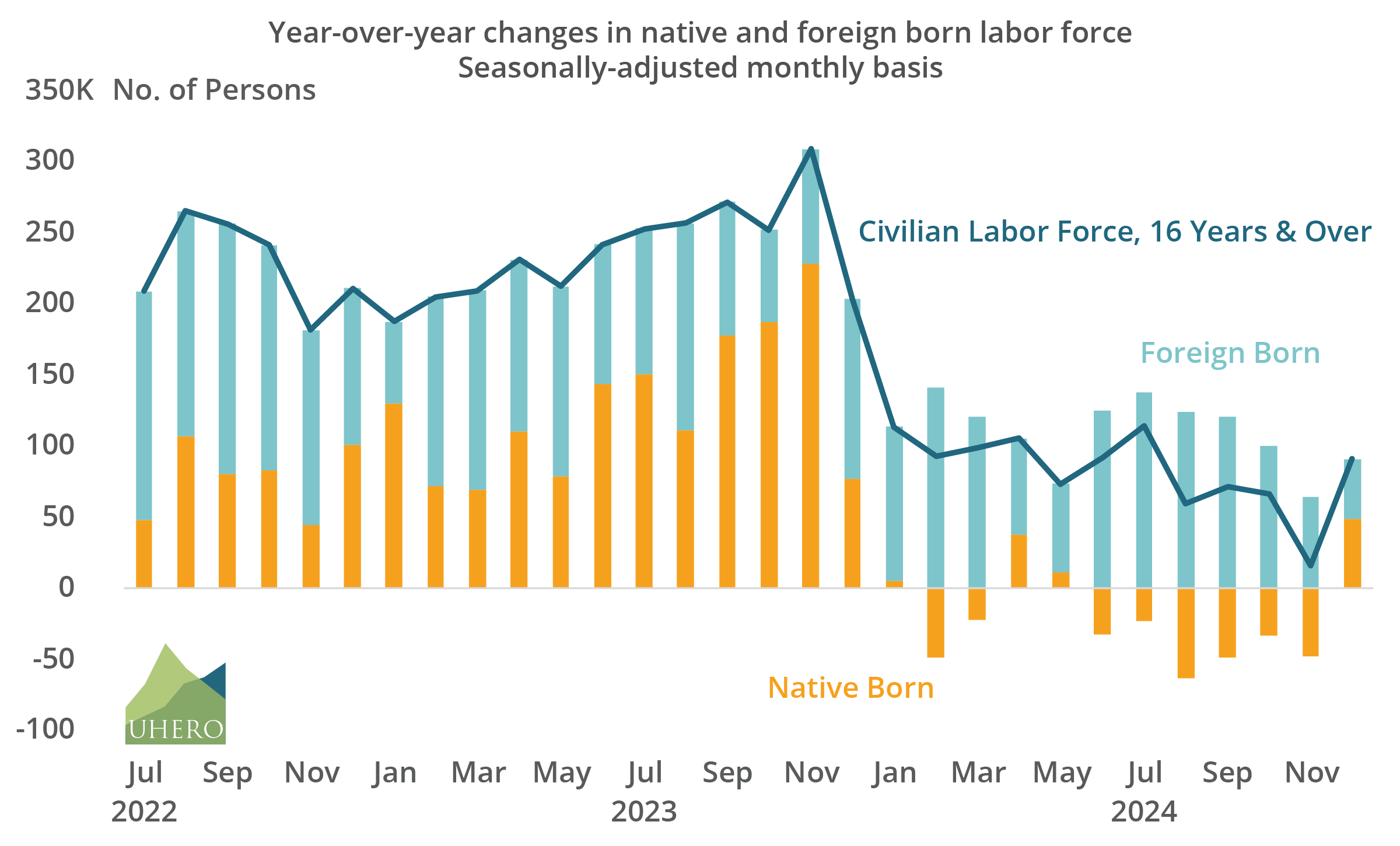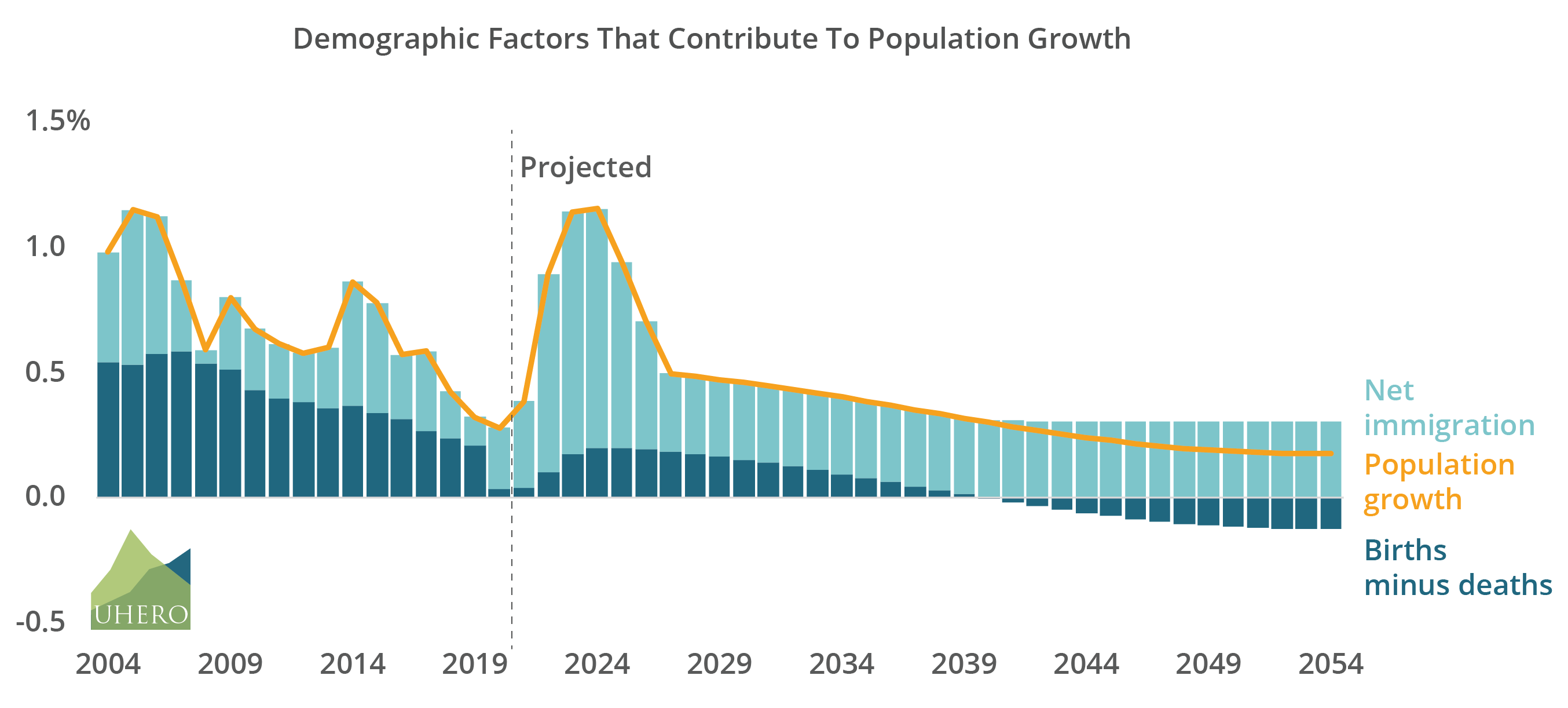BLOG POSTS ARE PRELIMINARY MATERIALS CIRCULATED TO STIMULATE DISCUSSION AND CRITICAL COMMENT. THE VIEWS EXPRESSED ARE THOSE OF THE INDIVIDUAL AUTHORS. WHILE BLOG POSTS BENEFIT FROM ACTIVE UHERO DISCUSSION, THEY HAVE NOT UNDERGONE FORMAL ACADEMIC PEER REVIEW.
By Byron Gangnes
Immigrants have always been an important part of America’s population. But for just as long there have been concerns about the impact of immigration on US society and the economy. The recent “surge” in unauthorized immigration at the Southern border and the candidacy of Donald Trump animated an already growing backlash against immigration. This is now playing out in early actions by the new Administration on many fronts. But what do we know about the economic effects of US immigration?
Takeaways
- Existing research generally finds that immigration has little or no adverse effect on the pay or employment of native-born workers in the short run and has clear positive benefits in the long run.
- Immigration has positive effects on the federal budget deficit, although it imposes short-term costs on state and local budgets, primarily because of the need to educate immigrant children.
- Immigration has mixed effects on the housing market, although the net effect is likely positive because of the large presence of both legal and unauthorized immigrants in the construction workforce.
- Fiscal costs of implementing proposed mass deportation programs would be large, and the net result for the US economy would be negative.
- The aging of the US population means that immigration will be essential to sustaining the US labor force and standard of living in coming decades.
Immigration and US society
Immigration is a central part of the American story. Immigrants from Northern Europe formed the Nation’s early foundations, and successive waves of new arrivals from across the globe helped drive US development. But we also have a long-standing love-hate relationship with immigration, seeing in these newcomers the embodiment of the American Dream and valuing their contributions to growth, while fearing the effects of cultural diversity and adverse economic consequences for native born residents.
The total immigrant population in the US numbered just under 48 million people in 2023. The vast majority of these non-native-born residents are legal immigrants—about three-quarters—with the remaining quarter considered unauthorized immigrants.[1] Immigrants to the US come from all over the world, with the largest number from Mexico, followed by Asia, other Latin American countries, and Europe and Canada.

Source: Migration Policy Institute, Pew Research Center, Congressional Budget Office, Center for Immigration Studies, World Bank.
As promised, newly inaugurated President Trump immediately advanced plans to shut down the immigration, refugee and asylum process, and he has begun to deport some unauthorized immigrants. While much remains unclear—and will be the subject of legal challenges—previous comments by candidate Trump suggest that his target may ultimately include all the 11-14 million unauthorized migrants currently within US borders.
What does economics tell us about the likely impact on the US economy and workers of immigration and the potential costs of mass deportation? The discussion below is not intended to be comprehensive but rather focuses on issues of particular current relevance.
Economic Effects: Wages and employment
A primary focus of those opposed to immigration is the potential for negative effects on wages and employment of native-born workers. The supply-demand logic argues that an influx of foreign-born laborers creates downward competitive wage pressure. Economics tells us the effect will depend on how similar in skills is the immigrant labor and whether new immigrants might instead work in jobs that are complementary to those of native-born workers. If the latter is true—for example low-skilled immigrant construction workers taking on the most basic tasks—this increases the productivity of more skilled workers and increases their wages.
The academic research on the employment effects of immigration is vast, with a variety of approaches and varying results. But broad studies of the literature have consistently found no, or at most very small, negative short-term effects on prevailing wages. For example, in their widely cited 1995 survey, Rachel Friedberg and Jennifer Hunt conclude that, “…a 10 percent increase in the fraction of immigrants in the population reduces native wages by at most 1 percent.” The results of more recent reviews are even stronger. For example, a 2022 study-of-studies (a meta-analysis) by C. Nedoncelle and others analyzed 64 papers published between 1972 and 2019. They found, “…an average negative, close-to-zero wage effect.” Existing studies typically find that short-run effects on employment are also small or negligible.
There are a limited number of papers that find significant negative labor market impacts on native-born workers. One that has garnered considerable attention is a study by George Borjas that challenged an influential 1990 paper by David Card. Card, now a Nobel Laureate, had identified a unique “natural experiment” in the 1980 Mariel Boatlift, which brought about 125,000 mostly low-skilled Cuban refugees to Miami. Perhaps surprisingly, he found that the arrival of these immigrants had no effect on wages or unemployment rates of low-skilled Miami natives. In a rebuttal first presented in 2015, Borjas instead reported a large decline in the wages of high school dropouts, whose skills were most similar to those of the Marielitos. Borjas’s findings remain controversial, with a number of studies challenging his analysis.
Over the long run, there is an overwhelming consensus that immigration has positive labor market effects. These stem from the complementary skills of immigrants, their effect on overall demand, and high rates of immigrant entrepreneurship. Immigration has also been shown to prompt upskilling by existing residents, who raise their own productivity and earnings by seeking additional education or employment experience.
Government budgets
Another common argument against immigration is the claim that immigrants are a burden on public finances. In fact, the opposite is true at the federal level, because immigrants pay far more in taxes than they receive in benefits. Perhaps surprisingly, this is particularly true for recent or unauthorized immigrants, who usually pay income and payroll taxes but do not qualify to receive many federal benefits, such as Social Security and non-critical Medicaid. The latter is demonstrated in a recent study by the Congressional Budget Office that showed that the unauthorized immigrant surge of 2022 to mid-2024 would actually reduce federal budget deficits by $900 billion over the next ten years.
Overall, immigration has been shown to have a significant positive effect on federal government finances. And increasing the number admitted legally would help substantially in shoring up funding for the Social Security system and other social safety net programs.

Source: Congressional Budget Office, Effects of the Immigration Surge on the Federal Budget and the Economy, July 2024.
The situation is different at the state and local level. Because public schools are required to provide education to all children regardless of immigration status, there is a net cost to state and local government budgets. This cost disappears in the long run as these students grow up and have their own children, but it is nevertheless a short-term budget burden.
Inflation
Inflation has been a substantial economic problem in the post-pandemic period. While the increased immigrant demand for goods and services could exert upward pressure on prices, officials have instead emphasized the positive effect on labor supply from immigrant inflows. Federal Reserve Governor Michell W. Bowman remarked in 2024,
“…much of the progress on inflation last year was due to supply-side improvements, including…increases in the number of available workers, due both to increased labor force participation and strong immigration….”
In fact, immigrants have made up essentially all the US labor force growth recently. Without them, the labor force would have declined, inflationary wage pressures would have risen, and economic growth could have ground to a halt.

Source: US Bureau of Labor Statistics
Housing
An interesting recent issue has been whether immigrants are contributing to rising home prices and therefore worsening the affordability crisis. This is a complex issue. Certainly, to the extent the immigrants compete with local buyers, they may drive up home prices. (Presumably on average this competition is at a relatively low price point.)
But the prevailing view among economists appears to be that the demand effect is limited relative to the overall market and the supply side is more important. See, for example Frost (2014) and the National Immigration Forum (2024). Immigrants make up 40% of construction workers in the Western and Southern US, more in some border states. Their labor has prevented the housing shortfall from being more severe than it is.
Deportation costs
President Trump has moved quickly to shut down existing refugee and asylum programs, challenge birthright citizenship, and to beef up the military presence along the Southern Border. He has begun to deport some unauthorized immigrants. He has pledged in the past to remove a very large number of these people, perhaps the entire 11-14 million.
A program of mass deportations would be massively expensive. While initial estimates vary widely, the fiscal cost to the federal government of deporting 11 million immigrants could range from $216 billion to $1 trillion over ten years, with significant ongoing costs into the future. See, for example, the American Immigration Council (2024) and msn.com (2024).
Estimates of the broader costs to the US economy from mass deportations are uncertain, but they typically run to very large numbers. Simulations of the Penn Wharton Budget Model, for example, find that even a 10% increase in deportations would reduce US real GDP by 3% after ten years. The Peterson Institute for International Economics estimates that deporting 1.3 million unauthorized immigrants would reduce US GDP by 1.2% and employment by 1.1%, with massively bigger adverse impacts for larger-scale deportations. Negative long-run effects are substantial because of the smaller US labor force, reduced productivity, inflationary pressure, and other factors.
Long-run growth
As in most other advanced economies, lower birth rates and the aging of the large post-World War II Baby Boom cohort are causing a rapid aging of the population. These forces will reduce labor force growth considerably in coming decades, leading to an outright decline in the absence of immigration. This would reduce economic growth and increase the burden on public finances.

Source: Congressional Budget Office, The Demographic Outlook: 2024 to 2054, January 2024.
Conclusion
Immigrants to the US play an important positive economic role, increasing the labor force, demand, and productivity. New immigrants, whether legal or unauthorized, have little or no adverse impact on the wages or employment opportunities of native-born workers. They contribute positively to government budgets at all levels in the long run. Mass deportation efforts will be costly to implement and will reduce US growth potential at a time when immigration will be increasingly important to maintaining needed labor force, tax revenue, and our standard of living.
In this blog post, I have deliberately avoided discussion of critical elements of the immigration situation. For one, I have not addressed the dramatic gains for immigrants themselves, many of whom are able to escape dire situations in home countries and dramatically improve their families’ economic prospects. By improving their lives, we also help to support a stronger global economy, which has long-term benefits for us, as well.
I have also avoided discussing the vast human toll that will be imposed if mass deportations are carried out. I am in no way attempting to minimize these costs. My choice to avoid them here is intended to maintain this blog’s focus purely on the main economic elements of the immigration debate.
Thanks to Steven Bond-Smith, Carl Bonham, Peter Fuleky, Andrew Mason, and Dan Kowalski for helpful insights.
1 Unauthorized immigrant is the generally preferred term used in academic and policy discussions. It has the same meaning as “undocumented” or “illegal” immigrant.